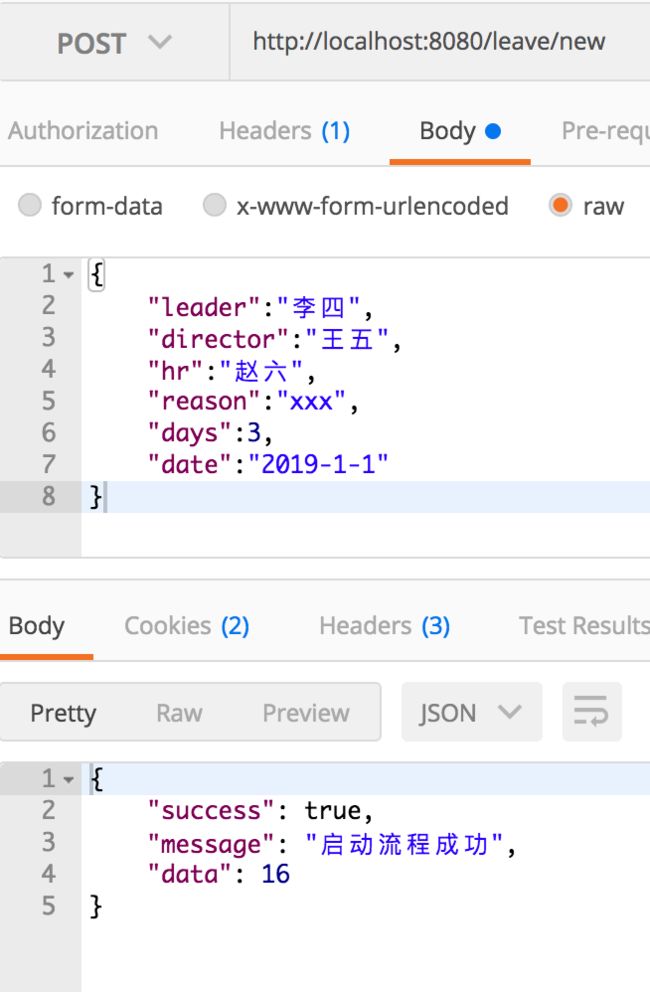JBPM 7.17 学习笔记(9)用spring boot+jbpm 实现请假流程
本文不使用 jBPM 的业务中心和执行服务器,只使用核心 API。
新建 spring-boot-web 项目
pom.xml 文件中添加如下依赖:
jboss-public-repository-group
JBoss Public Repository Group
http://repository.jboss.org/nexus/content/groups/public/
true
never
true
daily
org.kie
kie-api
${runtime.version}
org.drools
drools-core
${runtime.version}
org.drools
drools-decisiontables
${runtime.version}
net.minidev
json-smart
2.3
compile
com.google.guava
guava
23.0
...
流程图
流程图使用 eclpse 创建或者业务中心创建,流程图显示如下:

实现过程略,将 leave.bpmn 拷贝到项目的 resources 目录下。
AppConfiguration
在这个类中主要是 bean 的配置,这些 bean 会在控制器中注入,主要是和 jBPM 相关的类,比如 RuntimeManager、RuntimeEngine、KieSession 等:
@Configuration
@Component
public class AppConfiguration {
@Bean(name = "manager")
public RuntimeManager manager() {
JBPMHelper.startH2Server();
JBPMHelper.setupDataSource();
RuntimeEnvironment environment = RuntimeEnvironmentBuilder.Factory.get().newDefaultBuilder()
.userGroupCallback(new UserGroupCallback() {
public List getGroupsForUser(String userId) {
List result = new ArrayList<>();
if ("zhaoliu".equals(userId)) {
result.add("HR");
} else if ("wangwu".equals(userId)) {
result.add("PM");
}
return result;
}
public boolean existsUser(String arg0) {
return true;
}
public boolean existsGroup(String arg0) {
return true;
}
})
.addAsset(KieServices.Factory.get().getResources().newClassPathResource("leave.bpmn"), ResourceType.BPMN2)
.get();
return RuntimeManagerFactory.Factory.get().newSingletonRuntimeManager(environment);
}
@Bean(name="runtime")
public RuntimeEngine runtime(RuntimeManager manager){
return manager.getRuntimeEngine(null);
}
@Bean(name="ksession")
public KieSession ksession(RuntimeEngine runtime ){return runtime.getKieSession();}
@Bean(name="taskService")
public TaskService taskService(RuntimeEngine runtime){return runtime.getTaskService();}
}
控制器基类
首先编写一个 BaseController,在这个控制器中注入 Bean,实现一些常见功能,然后让其它控制器来继承它。
自动装配
对 AppConfiguration 中的 bean 进行 Autowire:
@Autowired
protected RuntimeManager manager;
@Autowired
@Qualifier("runtime")
protected RuntimeEngine runtime;
@Autowired
@Qualifier("ksession")
protected KieSession ksession;
@Autowired
@Qualifier("taskService")
protected TaskService taskService;
获取用户
为了简单起见,我们在用户登录后将用户名保存到 cookie 中。这个方法很简单,直接从 cookie 中获取用户名。这仅仅是处于演示的目的,请自行根据需要修改其实现。
protected String _getUser(HttpServletRequest req, JSONObject json) {
// 从请求参数中获取 username
String username = json.getAsString("username");
if (username != null) {
return username;
}
// 从 cookie 中获取 username
Cookie[] cookies = req.getCookies();
if (cookies != null) {
for (Cookie cookie : cookies) {
if (cookie.getName().equals("username")) {
username = cookie.getValue();
try {
username = URLDecoder.decode(username, "utf-8");
return username;
} catch (UnsupportedEncodingException e) {
e.printStackTrace();
}
}
}
}
return null;
}
获取待办
// 获取待办任务
protected BaseResponse _todoList(String username) {
BaseResponse result = new BaseResponse();
List list = taskService.getTasksAssignedAsPotentialOwner(username, "en-UK");
List> data = Lists.newArrayList();
for(TaskSummary task : list){
Map map = taskService.getTaskContent(task.getId());
Long pid = task.getProcessInstanceId();
map.put("taskId",task.getId());
map.put("pid",task.getProcessInstanceId());
map.put("status",task.getStatus());
map.put("applicant",_getVariable("applicant",pid));
map.put("leader",_getVariable("leader",pid));
map.put("director",_getVariable("director",pid));
map.put("hr",_getVariable("hr",pid));
data.add(map);
}
result.success = true;
result.data = data;
return result;
}
获取某个用户的待办很简单,只需要调用 taskService.getTasksAssignedAsPotentialOwner。但是必须指定用户名。
因为 TaskSummary 中的信息很简单,不包含全局变量中的请假人、请假时间 等信息,所以我们又从全局变量中获取了这些数据,一起返回给前端。
读取全局变量调用了 _getVariable() 方法,这个方法定义如下:
// 读取全局变量
protected Object _getVariable(String key,Long pId){
ProcessInstance pi = ksession.getProcessInstance(pId);
WorkflowProcessInstance processInstance = (WorkflowProcessInstance)pi;
return processInstance.getVariable(key);
}
kie API 隐藏了获取所有流程实例变量的方法(ProcessService 的 getVariables() 不再有效),要获取流程变量,只能调用
WorkflowProcessInstance 接口的getVariable()方法。
办理任务
// 办理任务
protected BaseResponse _doTask(Long taskId,String username,Map outParams) {
BaseResponse result = new BaseResponse() ;
TaskSummary task = _getTaskById(taskId,username);
if(task ==null){
result.message = "此任务无效-用户不拥有此任务或任务已完成";
return result;
}
taskService.start(taskId, username);
taskService.complete(taskId, username, outParams);
result.success = true;
result.message = "任务"+ taskId+"处理完成。";
return result;
}
这里将任务的 start 和 complete 合并到一起了,因为我们的流程中任务的分配全部都是自动分配的(通过 ActorId),所以不需要调用 claim 来认领任务。
_getTaskById 方法主要是做一个保护,防止用户办理了不属于自己的任务,或者已经办结的任务:
// 根据 id 获取任务
protected TaskSummary _getTaskById(Long taskId,String username){
List list = taskService.getTasksAssignedAsPotentialOwner(username, "en-UK");
List> data = Lists.newArrayList();
for(TaskSummary task : list){
if(taskId.equals(task.getId())){
return task;
}
}
return null;
}
就是通过对该用户的待办列表进行过滤,通过 id 找出对应的任务。如果找不到,则表明该任务不属于该用户,或者任务状态不对(比如已经办结),可以返回空。
登录
登录放在 LoginController 控制器中做。为了简单起见,这里并没有验证密码,直接将用户名放到 cookie 中:
@RequestMapping("/login")
@ResponseBody
public BaseResponse login(@RequestBody JSONObject json, HttpServletResponse res) {
BaseResponse result = new BaseResponse();
String username = json.getAsString("username");
Assert.hasText(username, "用户名不能为空");
result.message = username+"登录成功";
result.data = username;
try {
username = URLEncoder.encode(username, "utf-8");
} catch (UnsupportedEncodingException e) {
e.printStackTrace();
}
Cookie cookie = new Cookie("username", username);
cookie.setMaxAge(3600); //设置cookie的过期时间是3600s
res.addCookie(cookie);
result.success = true;
return result;
}
流程控制器
流程的启动、提交申请、审核、备案操作放在 LeaveProcessController 控制器(继承了 BaseController)。
启动流程
// 新建请假条
@RequestMapping("/new")
@ResponseBody
public BaseResponse newLeave(@RequestBody JSONObject form, HttpServletRequest req) {
BaseResponse result = new BaseResponse();
String username = _getUser(req, form);
if (StringUtils.isEmpty(username)) {
result.message = "请登录";
return result;
}
result = assertForm(form, username);// 表单不完整,不要创建流程实例,避免在数据库中生成一些无效的任务
if (result.success == false) {
return result;
}
form.put("applicant", username);
// 初始化一些默认值
form.put("applicantSubmit", false);
form.put("leaderAgree", false);
form.put("directorAgree", false);
form.put("hrRecord", false);
// 启动新的流程
// 这个 processId 必须匹配 .bpmn 文件中的 ID 属性。
ProcessInstance pi = ksession.startProcess("get-started.leave", form);
result.message = "启动流程成功";
result.success = true;
result.data = pi.getId();
return result;
}
用户启动流程时,需要提交一些表单数据(比如请假时间、事由、天数、请假人、审核人等),我们首先对数据进行一些简单校验(调用 assertForm 方法),然后调用 kesession.startProcess 启动流程,并将表单数据传入。这些数据会作为全局变量(流程实例变量)存在。
获取待办
// 获取待办
@RequestMapping("/todoList")
@ResponseBody
public BaseResponse todoList(@RequestBody JSONObject form, HttpServletRequest req) {
BaseResponse result = new BaseResponse();
String username = _getUser(req, form);
if (StringUtils.isEmpty(username)) {
result.message = "请重新登录";
return result;
}
return _todoList(username);
调用父类的 _todoList 方法,前面已经介绍。
提交申请
// 提交申请
@RequestMapping("/submitApplication")
@ResponseBody
public BaseResponse submitApplication(@RequestBody JSONObject form, HttpServletRequest req) {
BaseResponse result = new BaseResponse();
String username = _getUser(req, form);
if (StringUtils.isEmpty(username)) {
result.message = "请重新登录";
return result;
}
Number taskId = form.getAsNumber("taskId");
if (StringUtils.isEmpty(taskId)) {
result.message = "任务 id 不能为空";
return result;
}
Map outParams = new HashMap();
outParams.put("applicantSubmit_out", true);
result = _doTask(taskId.longValue(), username, outParams);
if (result.success) {
result.message = "提交申请成功,taskId = " + taskId;
}
return result;
}
跳过参数校验,其实只是调用了父类的 _doTask 方法而已。其中 outParams 设置了任务的输出参数 applicantSubmit_out。在流程定义中,这个输出参数绑定的是全局变量 applicantSubmit ,因此当 complete 之后,全局变量 applicantSubmit 为 true。
审批和备案
剩下的 3 个任务其实和提交申请是大同小异的,只不过输出参数不同而已:
// leader审批
@RequestMapping("/leaderApprove")
@ResponseBody
public BaseResponse leaderApprove(@RequestBody JSONObject json, HttpServletRequest req) {
BaseResponse result = new BaseResponse();
String username = _getUser(req, json);// 审批人
if (StringUtils.isEmpty(username)) {
result.message = "请重新登录";
return result;
}
boolean agree = json.getAsNumber("agree").intValue() != 0;// 0 驳回,1 同意
Number taskId = json.getAsNumber("taskId");// 待办 id
if (taskId == null) {
result.message = "任务 id 不能为空";
return result;
}
Map outParams = new HashMap();
outParams.put("leaderAgree_out", agree);
result = _doTask(taskId.longValue(), username, outParams);
if (result.success) {
result.message = "leader 审批" + (agree ? "通过" : "不通过") + ",taskId = " + taskId;
}
return result;
}
// director 审批
@RequestMapping("/directorApprove")
@ResponseBody
public BaseResponse directorApprove(@RequestBody JSONObject json, HttpServletRequest req) {
BaseResponse response = new BaseResponse();
String username = _getUser(req, json);// 审批人
if (StringUtils.isEmpty(username)) {
response.message = "请重新登录";
return response;
}
boolean agree = json.getAsNumber("agree").intValue() != 0;// 0 驳回,1 同意
Number taskId = json.getAsNumber("taskId");// 待办 id
if (taskId == null) {
response.message = "任务 id 不能为空";
return response;
}
Map outParams = new HashMap();
outParams.put("directorAgree", agree);// Not directorAgree_out !!!
response = _doTask(taskId.longValue(), username, outParams);
if (response.success) {
response.message = "director 审批" + (agree ? "通过" : "不通过") + ",taskId = " + taskId;
}
return response;
}
// hr 备案
@RequestMapping("/hrRecord")
@ResponseBody
public BaseResponse hrRecord(@RequestBody JSONObject json, HttpServletRequest req) {
BaseResponse res = new BaseResponse();
String username = _getUser(req, json);// 审批人
if (StringUtils.isEmpty(username)) {
res.message = "请重新登录";
return res;
}
Number taskId = json.getAsNumber("taskId");// 待办 id
if (taskId == null) {
res.message = "任务 id 不能为空";
return res;
}
Map outParams = new HashMap();
outParams.put("hrRecord_out", true);
res = _doTask(taskId.longValue(), username, outParams);
if (res.success) {
res.message = "director 备案通过,taskId = " + taskId;
}
return res;
}
测试
打开 postman 进行接口测试。测试结果如下。
登录:

提交申请:

获取待办:

审批:

前端测试:
